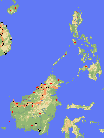
Range of Dacrydium pectinatum (1). Adapted from a map by
www.expediamaps.com
Common Names
"Mélo, Natuna; Borneo: malur, Mangar, melur, Singkawang, tjemantan, Sampit, sempilor, Sarawak, Sabah" (1).Taxonomic notes
Syn: D. pectinatum var. robustum de Laub. 1969 (1).Description
"Small to large tree, 3 to 40 m tall, with numerous branchlets forming a dense rounded crown. Juvenile leaves up to 18 mm long, slightly curved, pungent, strongly keeled and quadrangular in cross section, 0.2 mm wide and thick, gradually becoming shorter and thicker. Adult leaves keeled on four sides but less strongly on the axial side, abruptly acute to blunt, slightly curved, 2-5 by 0.4-0.8 mm wide and thick. Fertile structures terminal. Pollen cone 6-12 mm long and 2 mm diam., apex of microsporophyll 1-1.2 mm long. The seed-bearing structure subtended by a short zone of small leaves c. 2 mm long while the cone bracts themselves may be up to 3 mm long. Seed 4-4.5 mm long" (1).Range
China: Hainan; Malesia: Billiton, Borneo (common; incl. Karimata & Natuna Is.) and Philippines (Luzon: Sierra Madre; Mindanao: Zamboanga). "Scattered large individuals are found in primary rain-forest other than dipterocarp forest from sea-level to 1500 m but mostly below 600 m, while dense stands are found in boggy areas and nearly pure stands of stunted trees occur in shallow sandy soils, especially on so-called 'padangs', and on kerangas in heath forest, frequently associated with Gymnostoma; in Sabah also on ultrabasic soils. In Kayangeran For. Res. (Brunei) reported to occur in pure stands in the centre of peat swamps" (1).Big Tree
Oldest
Dendrochronology
Ethnobotany
Observations
Remarks
"This species closely resembles the lowland form of D. nidulum from which it differs by the more robust leaves and by the fully exposed mature seed. Dacrydium balansae in New Caledonia and D. cupressinum in New Zealand are also similar. The variety was created for markedly shorter leaves, a condition which, it turns out, is related to more difficult environments and all variations can be seen in local populations across environmental gradients" (1).Citations
(1) de Laubenfels 1988See also:
de Laubenfels 1969 (p.289).
de Laubenfels , Kalikasan 7 (1978) 121.
Gaussen, Gymn. Act. & Foss. fasc. 13, ch. 20 (1974) 42, f. 689.
Silba 1986.
[Dacrydium] [Podocarpaceae] [home]
This page is from the Gymnosperm Database
URL: http://www.geocities.com/RainForest/Canopy/2285/po/da_m/pectinatum.htm
Edited by Christopher J. Earle
E-mail:earlecj@earthlink.com
Last modified on 29-Jan-1999